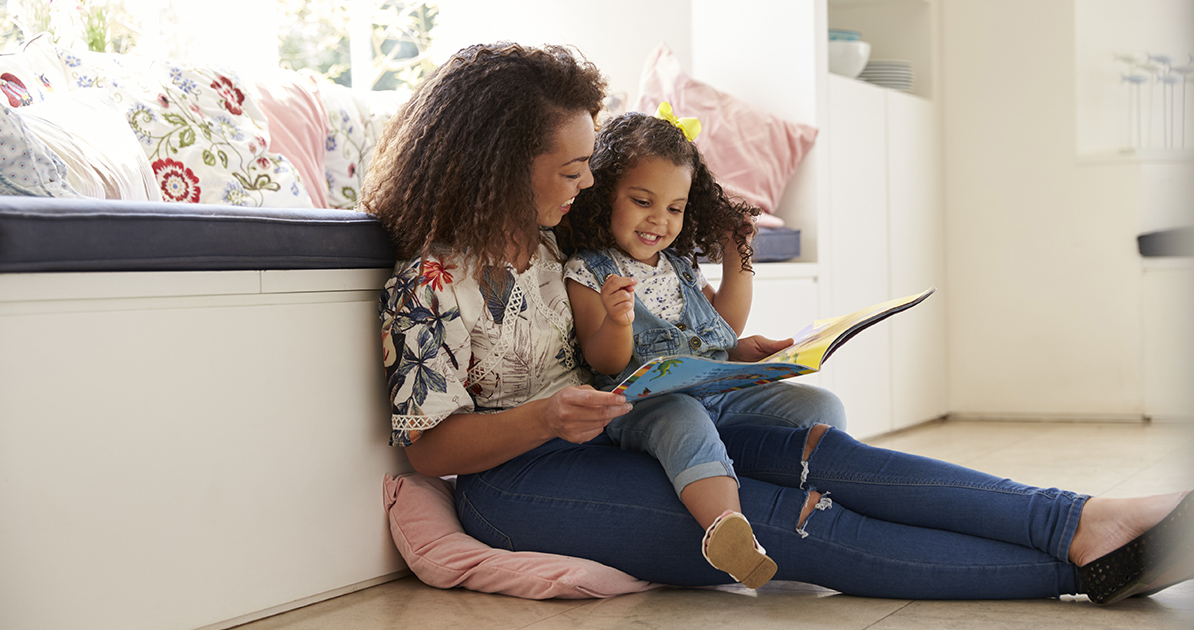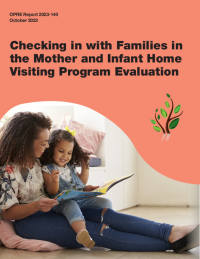Checking in with Families in the Mother and Infant Home Visiting Program Evaluation

Introduction
The overarching goal of the Mother and Infant Home Visiting Program Evaluation (MIHOPE) is to provide information about whether families and children benefit from Maternal, Infant, and Early Childhood Home Visiting (MIECHV) Program-funded early childhood home visiting programs as they operated from 2012 to 2017, and if so, how. The MIECHV Program is administered by the Health Resources and Services Administration (HRSA) in collaboration with the Administration for Children and Families (ACF).
The MIHOPE study team first estimated the effects of MIECHV-funded early childhood home visiting programs on family and child outcomes around the time the study child was 15 months of age.
Given the evidence of long-term effects of home visiting from prior studies of the four evidence-based models included in MIHOPE, ACF and HRSA were interested in measuring the effects of home visiting for families in the MIHOPE sample when children were in kindergarten.[1] To ensure that the study was in a strong position to conduct this later data collection with families, the MIHOPE team asked families for updated contact information when children were about 2.5 and 3.5 years of age.
Primary Research Questions
This report describes the process the study team used to maintain contact with families between the 15-month follow-up and kindergarten data collection and how successful the team was in maintaining contact.
In addition, this report addresses the following questions:
- What were families’ life circumstances at the time of these check-ins and how had their circumstances changed since they entered the study? The report describes trends in families’ life circumstances in the areas of maternal health, child health, and family economic self-sufficiency from the time women enrolled in MIHOPE through the 3.5-year check-in point.
- What were the effects of home visiting programs at the time of these check-ins? The report compares the outcomes of the program and control groups for six confirmatory outcomes, in four outcome areas, using data from the two check-ins.
Purpose
To ensure that the study was in a strong position to conduct later data collection with families, the MIHOPE team asked families for updated contact information when children were about 2.5 and 3.5 years of age. These two time points were chosen because they provided the opportunity to check in with MIHOPE families at relatively equal intervals between the initial in-depth follow-up when children were 15 months old and a follow-up when the children were in kindergarten to maximize the study’s opportunity of maintaining contact with families.
Although the primary purpose of checking in with families was to obtain updated contact information, families were also asked to complete brief surveys so that the team could obtain some information about families’ current circumstances at these two time points. This report uses data from these brief check-ins with MIHOPE families to provide a snapshot of families’ life circumstances and the effects of MIECHV-funded evidence-based home visiting at these time points. Because data was obtained via a 30-minute survey with mothers, the study team could only measure a limited set of outcomes and could not comprehensively assess any of the domains specified in the MIECHV authorizing legislation. The outcome areas assessed were maternal health, child health, family economic self-sufficiency, discipline practices and strategies, parental support for cognitive development, and child functioning.
Key Findings and Highlights
- At the 2.5-year check-in point, the study team maintained contact with 70 percent of families—51 percent of families responded to the survey and contact information was confirmed for an additional 19 percent of families. At the 3.5-year check-in point, the study team maintained contact with 65 percent of families—48 percent of families responded to the survey and contact information was confirmed for an additional 17 percent of families.
- The study team examined trends in program group families’ life circumstances from the time women enrolled in MIHOPE through the 3.5-year check-in point, on measures related to maternal health, child health, and family economic self-sufficiency. These three areas were included because the study team obtained relatively consistent information on them across all time points. Program group families’ circumstances remained fairly similar over time on most measures, but four trends emerged. MIHOPE participants achieved higher levels of education and reported lower levels of receipt of public assistance benefits at later time points. Not unexpectedly, women gave birth to additional children and used non-parental child care at higher rates as their children grew older.
- Of the six confirmatory outcomes examined at each time point, only one estimated effect was statistically significant. These results suggest that home visiting did not have effects on these particular outcomes measured via parent report when children were 2.5 and 3.5 years of age. However, none of the outcome areas examined could be comprehensively assessed at these check-in points, in contrast to the extensive data collected during the MIHOPE follow-up that occurred when children were 15 months of age (which included a one-hour parent survey, administrative data sources, direct assessments, and observations of parents and children). Statistical tests the team conducted to assess the patterns of estimated effects for all outcomes (confirmatory and exploratory) in each outcome area suggest positive effects in the areas of parental support for cognitive development (on outcomes related to the home literacy environment and cognitive stimulation) and child functioning (on outcomes related to child self-regulation).
Methods
All families who enrolled in MIHOPE were invited to complete a 30-minute survey on the web or by telephone at each check-in point. The 2.5-year survey was fielded from September 2015 to June 2018, and the 3.5-year survey was fielded from June 2017 to June 2019.
In addition to asking families to update their contact information so that they could be contacted in the future, the surveys included a limited set of questions about six outcome areas:
- the respondent’s health
- the child’s health
- family economic self-sufficiency
- discipline practices and strategies
- parental support for cognitive development (in particular, home literacy environment and cognitive stimulation)
- child functioning (which was only included at the 3.5-year check-in point)
In creating the surveys, the team chose measures that could be administered on the web or over the telephone to mothers and were fairly brief, so that some information on several outcome areas could be collected; however, this also meant that no outcome area could be assessed as comprehensively as it had been at the MIHOPE 15-month follow-up. In addition, two outcome areas that home visiting programs try to affect—child maltreatment and intimate partner violence—were intentionally excluded because the study team did not want these sensitive topics to become the focus of the brief survey, which could discourage respondents from completing the rest of the survey or completing future data collection efforts. Decisions about which measures to include on the surveys had to be made before the 15-month data collection had concluded so that the surveys could be conducted when children were 2.5 and 3.5 years of age, which meant that the analysis of 15-month impacts could not inform the survey content.
[1] Michalopoulos, Faucetta, Warren, and Mitchell (2017).
Document Details
Faucetta, Kristen, Charles Michalopoulos, Ximena A. Portilla, and Kelly Saunders 2023. Checking in with Families in the Mother and Infant Home Visiting Program Evaluation. OPRE Report 2023-140. Washington, DC: Office of Planning, Research, and Evaluation, Administration for Children and Families, U.S. Department of Health and Human Services.






